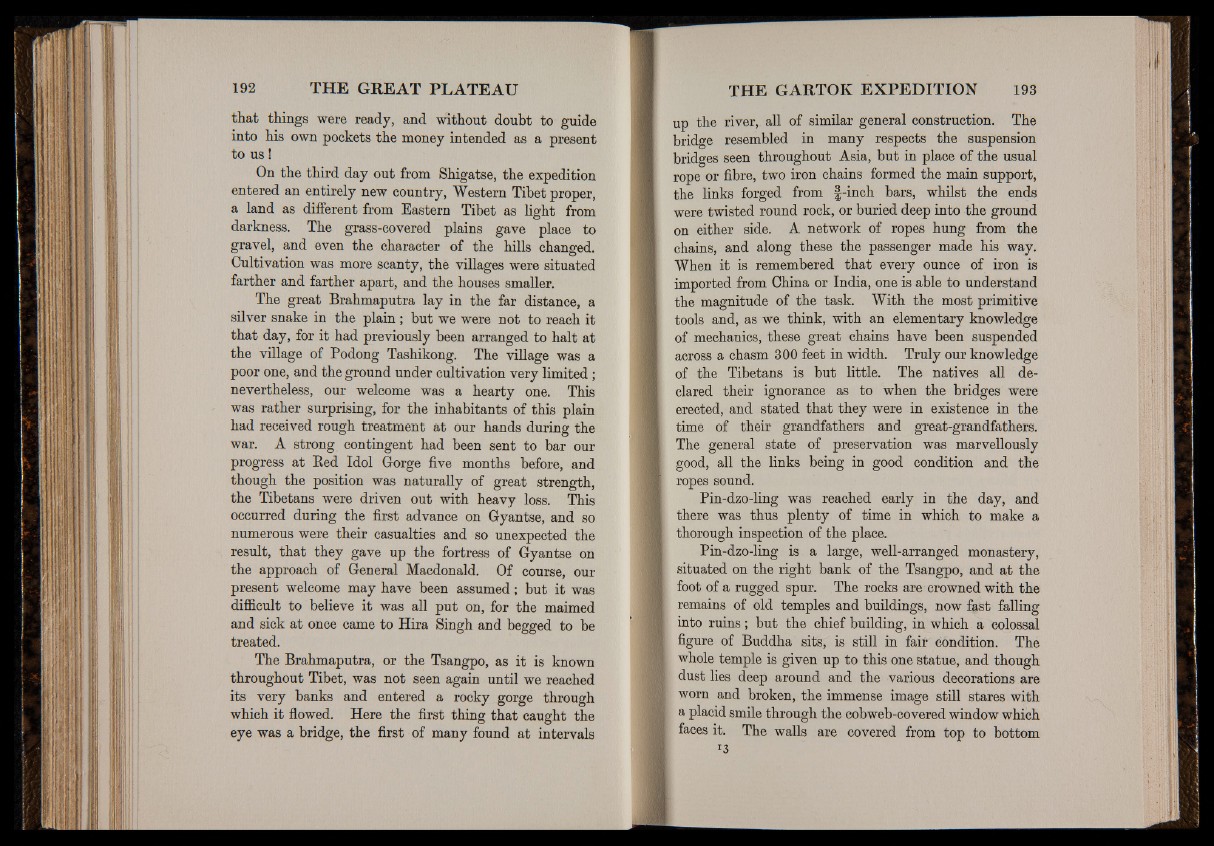
that things were ready, and without doubt to guide
into his own pockets the money intended as a present
to u s !
On the third day out from Shigatse, the expedition
entered an entirely new country, Western Tibet proper,
a land as different from Eastern Tibet as light from
darkness. The grass-covered plains gave place to
gravel, and even the character of the hills changed.
Cultivation was more scanty, the villages were situated
farther and farther apart, and the houses smaller.
The great Brahmaputra lay in the far distance, a
silver snake in the plain; but we were not to reach it
that day, for it had previously been arranged to halt at
the village of Podong Tashikong. The village was a
poor one, and the ground under cultivation very limited ;
nevertheless, our welcome was a hearty one. This
was rather surprising, for the inhabitants of this plain
had received rough treatment at our hands during the
war. A strong contingent had been sent to bar our
progress at Red Idol Gorge five months before, and
though the position was naturally of great strength,
the Tibetans were driven out with heavy loss. This
occurred during the first advance on Gyantse, and so
numerous were their casualties and so unexpected the
result, that they gave up the fortress of Gyantse on
the approach of General Macdonald. Of course, our
present welcome may have been assumed; but it was
difficult to believe it was all put on, for the maimed
and sick at once came to Hira Singh and begged to be
treated.
The Brahmaputra, or the Tsangpo, as it is known
throughout Tibet, was not seen again until we reached
its very banks and entered a rocky gorge through
which it flowed. Here the first thing that caught the
eye was a bridge, the first of many found at intervals
up the river, all of similar general construction. The
bridge resembled in many respects the suspension
bridges seen throughout Asia, but in place of the usual
rope or fibre, two iron chains formed the main support,
the links forged from f-inch bars, whilst the ends
were twisted round rock, or buried deep into the ground
on either side. A network of ropes hung from the
chains, and along these the passenger made his way.
When it is remembered that every ounce of iron is
imported from China or India, one is able to understand
the magnitude of the task. With the most primitive
tools and, as we think, with an elementary knowledge
of mechanics, these great chains have been suspended
across a chasm 300 feet in width. Truly our knowledge
of the Tibetans is but little. The natives all declared
their ignorance as to when the bridges were
erected, and stated that they were in existence in the
time of their grandfathers and great-grandfathers.
The general state of preservation was marvellously
good, all the links being in good condition and the
ropes sound.
Pin-dzo-ling was reached early in the day, and
there was thus plenty of time in which to make a
thorough inspection of the place.
Pin-dzo-ling is a large, well-arranged monastery,
situated on the right bank of the Tsangpo, and at the
foot of a rugged spur. The rocks are crowned with the
remains of old temples and buildings, now fast falling
into ruins; but the chief building, in which a colossal
figure of Buddha sits, is still in fair condition. The
whole temple is given up to this one statue, and though
dust lies deep around and the various decorations are
worn and broken, the immense image still stares with
a placid smile through the cobweb-covered window which
faces it. The walls are covered from top to bottom